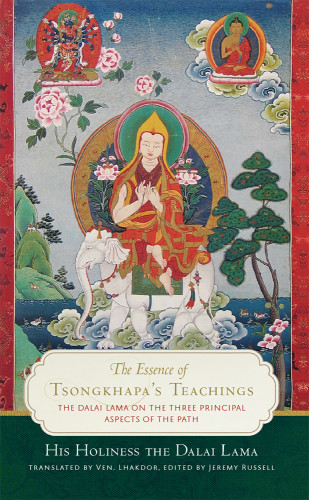Product desciption
The Essence Of Tsongkhapas Teachings The Dalai Lama On The Three Principal Aspects Of The Path Dalai Lama by Dalai Lama, Jeremy Russell, Lhakdor 9781614295945, 9781614295693, 9782018029709, 2018029703, 1614295948, 1614295697 instant download after payment.
Learn from the Dalai Lama the three steps to awakening: 1) renunciation, 2) the awakening mind, and 3) emptiness.
His Holiness the Dalai Lama’s commentary on Tsongkhapa’s Three Principal Aspects of the Path helps us integrate the full Buddhist path into our own practice. His Holiness offers a beautiful elucidation of the three aspects of the path: true renunciation based on the wish for freedom, the altruistic awakening mind ( bodhichitta ), and the correct view of emptiness. These three aspects of the path are the axis of all the practices of both sutra and tantra, and they encapsulate Tsongkhapa’s vision of the Buddhist path in its entirety. In their absence, it is impossible for us to develop the great compassion that aspires to liberate other sentient beings from samsara and we will not be able to go beyond this cycle of existence.
Practitioners will find The Three Principal Aspects of the Path invaluable as a manual for daily meditation. The universal and timeless insights of this text speak to contemporary spiritual aspirants, East and West. The root verses are presented in both Tibetan and English translation to accompany these profound teachings.
Review
When I first studied Jé Tsongkhapa’s root text on the Three Principal Aspects of the Path several decades ago, I recognized I had encountered the essence of all the Mahayana teachings of the Buddha, and the indispensable foundation of the Vajrayana. I knew that I could entrust myself to these three principles in all my lifetimes until enlightenment, and my faith in them has only deepened during the ensuing years. In this precious volume, His Holiness the Dalai Lama has brought his vast erudition and profound insights to elucidating this text for the modern world, for which I offer my humble gratitude and joyful appreciation.
(―B. Alan Wallace, President, Santa Barbara Institute for Consciousness Studies)
I teach my students about bodhisattva practice in terms of the three main aspects of the path: determination to be free, bodhicitta, and correct view. I am thrilled to see that we now have Tsongkhapa's pithy and profound verses on this topic along with the Dalai Lama's lucid commentary. This is a short, readable book––and a great introduction to Mahayana practice. It includes Tsongkhapa's original text in Tibetan, so it could also be used quite effectively as a text for teaching the translation of classical Tibetan.
(―Guy Newland, Chair, Department of Philosophy and Religion, Central Michigan University)
About the Author
Tenzin Gyatso, the Fourteenth Dalai Lama, is the spiritual leader of the Tibetan people. Forced to escape to India in 1959, he set up the Tibetan government-in-exile in Dharamsala, working to secure the welfare of the more than 100,000 Tibetan exiles and prevent the destruction of Tibetan culture. In his capacity as a spiritual and political leader, he has traveled to more than sixty-two countries on six continents and met with presidents, popes, and leading scientists to foster dialogue and create a better world. In recognition of his tireless work for the nonviolent liberation of Tibet, the Dalai Lama was awarded the Nobel Peace Prize in 1989. In 2012, he relinquished political authority in his exile government and turned it over to democratically elected representatives.
His Holiness frequently states that his life is guided by three major commitments: the promotion of basic human values or secular ethics in the interest of human happiness, the fostering of interreligious harmony, and securing the welfare of the Tibetan people, focusing on the survival of their identity, culture, and religion. As a superior scholar trained in the classical texts of the Nalanda tradition of Indian Buddhism, he is able to distill the central tenets of Buddhist philosophy in clear and inspiring language, his gift for pedagogy imbued with his infectious joy. Connecting scientists with Buddhist scholars, he helps unite contemplative and modern modes of investigation, bringing ancient tools and insights to bear on the acute problems facing the contemporary world. His efforts to foster dialogue among leaders of the world's faiths envision a future where people of different beliefs can share the planet in harmony.


